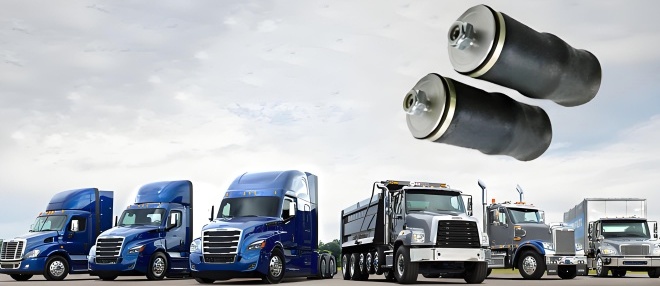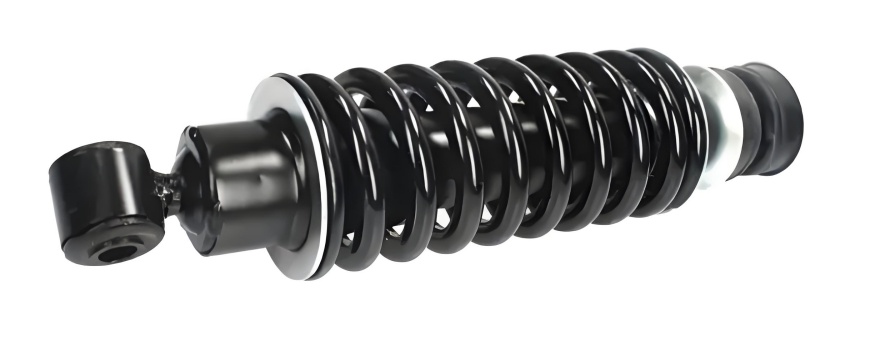
A six-axle semi-trailer is going downhill at a speed of 40 kilometers per hour on the Panshan Highway in Zhaotong, Yunnan. The 32 tons of building materials on board make each wheel withstand more than 5 tons of continuous pressure. The working temperature of traditional car shock absorbers is generally between -30 ° C and 120 ° C. While the hydraulic oil temperature of heavy truck shock absorbers can soar to 160 ° C under continuous braking conditions, which requires the sealing system to be made of fluororubber instead of ordinary nitrile rubber.
The US SAE standard test shows that when a truck passes through a 15cm deep pit at a speed of 25km/h, the shock absorber piston rod needs to withstand an instantaneous impact force of more than 8000N. To cope with this extreme working condition, Scania's latest shock absorber adopts a third-order damping design, which achieves progressive buffering through three sets of oil drain valves with different apertures, resulting in a 27% increase in impact force attenuation efficiency.
Lab data from ZF in Germany showed that trucks equipped with intelligent electronically controlled shock absorbers reduced the roll angle by 19% and the braking distance by 2.3 meters in the emergency avoidance test. This technology, which adjusts the damping force in real time through the ECU, has begun to spread in mid- to high-end tractors.
A comparison test of a domestic heavy truck manufacturer shows that the piston ring made by powder metallurgy process wears only 1/8 of the traditional iron castings in the 100,000-kilometer durability test. This technology of embedding ceramic particles in the metal matrix makes the service life of key moving parts exceed the 800,000-kilometer mark. In the open-pit mining area of Inner Mongolia, the temperature difference between day and night can reach 50 ° C. After a brand of engineering vehicle shock absorber adopts graphene-modified hydraulic oil, the low-temperature fluidity is increased by 40%, and the high-temperature viscosity stability is increased by 35%. This nanomaterial with a carbon content of only 0.03% has completely changed the performance boundary of traditional hydraulic oils. Volvo Trucks' newly released "Adaptive Air Suspension System" uses 128 pressure sensors and 4 accelerometers to build a digital twin that can predict road undulations 150 milliseconds in advance. This technology reduces the vibration of cold chain trucks to less than 0.6g, perfectly meeting the needs of precision instrument transportation.
On the Gobi Highway in Xinjiang, a logistics fleet discovered through a vibration spectrum analyzer that when the operating frequency of the shock absorber exceeded 28 Hz, the temperature of the cylinder increased abnormally by 0.5 ° C. This predictive maintenance strategy based on big data analytics advanced the time of fault detection by 400 working hours.
The maintenance manual of Isuzu in Japan shows that the performance decay rate of the parts with fully synthetic shock absorber oil is only 1/3 of that of mineral oil during the 30,000-kilometer maintenance cycle. However, it needs to be used with a special filter, otherwise the oil cleanliness is difficult to maintain the NAS7 standard.
The measured data of a refit factory in Shenzhen shows that the construction vehicle equipped with hydraulic buffer limiter extends the overhaul period of the shock absorber from 8 months to 22 months when driving on the gravel road of the construction site. This additional device worth 800 yuan effectively inhibits the excessive compression of the piston rod. 
| indicator | Traditional shock absorber | Smart shock absorber | increase |
|---|---|---|---|
| response time | 120ms | 25ms | 79% |
| Temperature adaptation range | -30~120℃ | -50~180℃ | 60% |
| energy absorption efficiency | 68% | 92% | 35% |
| service life | 300,000 kilometers | 800,000 kilometers | 167% |
Foundation shock absorption era (before 1980)
Cast iron cylinder + mineral oil
Maximum load-bearing capacity 15 tons
Maintenance cycle 5000 kilometers
The era of enhanced hydraulics (before 2000)
Chrome Plated Piston Rod + Synthetic Oil
Maximum load of 25 tons
Maintenance cycle 20,000 km
The age of intelligent control (today)
Electronically controlled damping + air suspension
Maximum load bearing 40 tons
Support for remote diagnostics
In the era of smart logistics, truck shock absorbers have evolved from simple mechanical components to the core unit of intelligent chassis systems. It is not only the absorber of physical shocks, but also the decision center of the dynamic performance of the whole vehicle. With the development of solid-state damping materials and AI control algorithms, the future shock absorption system may realize energy recovery and active road shape, opening up a new technical path for green logistics while ensuring transportation safety.
Summary of core points
Modern shock absorbers feature a progressive damping design and an intelligent temperature control system to handle extreme operating conditions
Nanocomposites and digital twin technologies drive product performance iteration
Predictive maintenance systems more than double the lifespan of critical components
Next generation products will integrate energy recovery with AI traffic anticipation